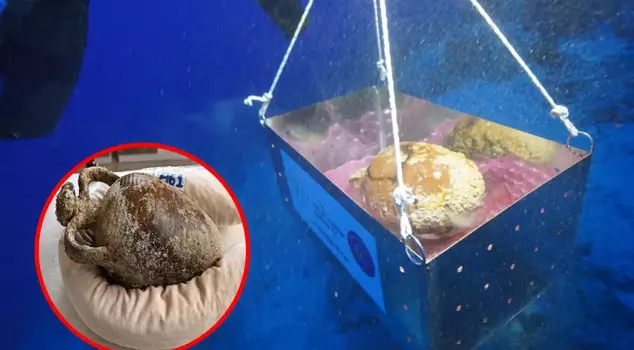
27.04.2025 17:21
During underwater excavations conducted with the help of robots off the coast of Kaç district in Antalya, a sealed amphora dating back 1100 years was discovered from a shipwreck. This development has generated great excitement among archaeologists, while scientists eagerly await the results.
The head of the Department of Conservation and Restoration of Cultural Heritage at Akdeniz University, Assoc. Dr. Hakan Öniz, and a diving team of 20 are conducting an underwater excavation off the coast of the Mediterranean.
CLOSED-MOUTH AMPHORA FOUND
The team working on behalf of the Antalya Museum under the "Heritage for the Future Project" of the Ministry of Culture and Tourism conducted an excavation at a depth of several meters in the sea near Besmi Island in the Kaş district using robots. The team, which successfully retrieved a closed-mouth amphora from a shipwreck at a depth of approximately 45-50 meters, experienced great excitement.
WORK STARTED TO DETERMINE WHAT WAS INSIDE
The amphora, which was taken to the Underwater Archaeology Laboratory of Akdeniz University in Kemer after being subjected to certain stages without being directly brought ashore, was first examined with the help of microscopes and special magnifiers. Then, experts from the Antalya Regional Council and laboratory restorers opened the mouth of the amphora with a meticulous one-hour effort using chisels, hammers, and small tools. The experts began analysis work to determine what the materials inside the amphora were by taking samples from it.
"A TRADE SHIP THAT SANK OFF THE COAST OF GAZA 1100 YEARS AGO"
The head of the excavation team, Assoc. Dr. Hakan Öniz, told AA correspondent that they believe the trade ship that set sail from the Gaza coast of Palestine 1100 years ago sank off the Mediterranean coast due to a possible storm. He explained that olive oil was the main export product of Gaza at that time and that wine was likely exported from Tekirdağ Şarköy-Gaziköy, stating, "This trade ship is one that visited multiple ports. It is from the period of the 9th and 10th centuries, during the Abbasid rule, which was the period of Islamic dominance. By looking at the amphoras that possibly carried wine on the ship, we do not think that the people in Palestine consumed wine, but we believe it could have been materials sent as gifts to migrants, Christian pilgrims, or those visiting Jerusalem."
"WAITING FOR THE RESULT IS MUCH MORE EXCITING"
Öniz noted that this is a very rare situation in the world and stated: "The fact that the mouth of the amphora has remained closed for over a thousand years is a unique situation. I think it could contain olive seeds, olive oil, wine, or fish sauce, but it could also be something completely different. It is indeed a very exciting process because it is a closed-mouth amphora. After 1100 years, the mouth of the amphora was opened, and what is inside will be revealed after the analysis process. The opening was exciting, but waiting for the result is much more exciting."
"THE PROCESS WILL BE LONG"
Prof. Dr. Meltem Asiltürk Ersoy, a faculty member of the Department of Materials Science and Engineering at Akdeniz University, also stated that this will be the first time in her professional career that she will examine the materials inside a closed amphora.
Ersoy explained that muddy samples were observed, saying, "We will try to understand what has happened over the 1100-year period in the marine environment, both under pressure and due to temperature changes. Scientific studies do not happen with a single analysis; many analyses need to corroborate each other. Therefore, this process will be long. We will present the results to the world of science and archaeology by combining the analysis results with information from that period."
The restorer conservator Rabia Nur Akyüz, who carried out the salt removal and opening of the amphora's lid, explained that they worked carefully to ensure that the amphora remained constantly wet to prevent the formations on it from drying out.